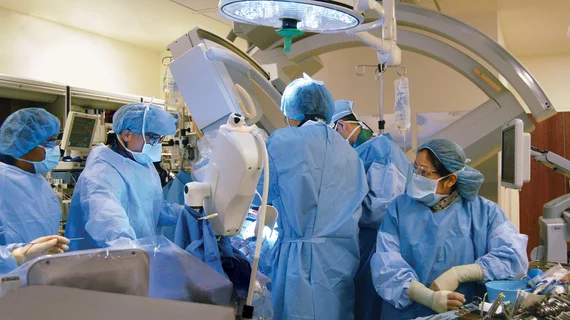TAVR outcomes take a hit when patients present with heart failure or hypertrophic cardiomyopathy
Patients with heart failure or hypertrophic cardiomyopathy face a higher risk of adverse outcomes after undergoing transcatheter aortic valve replacement (TAVR), according to two new studies published in the American Journal of Cardiology.
Both studies examined data from the U.S. Nationwide Readmissions Database.
TAVR and heart failure
The first study focused on 30-day outcomes for TAVR patients presenting with and without heart failure.[1]
“Heart failure is one of the most common comorbidities among patients who undergo TAVR,” wrote first author Salman Zahid, MD, of the department of medicine at Rochester General Hospital in New York, and colleagues. “Current literature on short-term outcomes among these high-risk patients remains limited.”
Zahid et al. focused on more than 246,000 TAVR patients treated from October 2015 to November 2019. Overall, 33.9% of patients also presented with heart failure. The median age of patients with heart failure (82 years old) was one year older than the median age of patients without heart failure (81 years old).
Heart failure patients were also linked to a higher 30-day readmission rate (12.3% vs. 10.4%) and 30-day readmission mortality (5.4% vs. 3%). Also, acute kidney injury, cardiogenic shock and the need for mechanical circulatory support were all more likely among readmitted patients who had heart failure. Lengths of stay were also approximately one day longer for these patients, and the hospitalization costs were higher.
“Our study results show that concomitant heart failure during index hospitalization for TAVR is a significant burden on the health system, and is associated with increased short-term risks of mortality and readmission,” the authors wrote. “The current TAVR risk calculator is useful in evaluating in-hospital mortality risk; however, given the results of our study, assessment of readmission risk along with mortality risk may be valuable to health systems and payers.”
With these findings in mind, the group added, structural heart teams should “be mindful of intraprocedural issues unique to TAVR, such as paravalvular leak and prosthesis-patient mismatch, that can precipitate heart failure.”
TAVR and hypertrophic cardiomyopathy
The second study examined the impact of TAVR on patients presenting with hypertrophic cardiomyopathy (HCM).[2]
“The landmark clinical trials on the utility of TAVR excluded patients with HCM and concomitant severe aortic stenosis,” wrote first author Matthew DiMeglio DO, MBA, of the division of hospital medicine at Thomas Jefferson University Hospital in Philadelphia, and colleagues. “TAVR in HCM presents unique technical or physiologic challenges called ‘suicide left ventricle,’ that is, sudden reduction in afterload after TAVR exacerbates subvalvular obstruction, which leads to hemodynamic collapse. Despite this, TAVR has increasingly been used in patients with HCM with no large-scale data on its safety.”
DiMeglio et al. tracked data from more than 223,000 TAVR patients treated from 2016 to 2019. Of that cohort, 0.53% presented with HCM. The authors then propensity score-matched 966 TAVR patients with HCM and 978 TAVR patients without HCM.
HCM patients were not more likely to present with comorbidities such as heart failure, hypertension or chronic obstructive pulmonary disorder. However, they did face a significantly higher risk of experiencing a net adverse cardiovascular event (NACE) than patients without HCM (7.2% vs. 4.4%). HCM was also linked to higher risks of in-hospital mortality (5.1% vs. 0.6%) and cardiogenic shock (1.3% vs. 0.2%).
These higher risks, the authors added, “could plausibly be related to the unmasking of subvalvular outflow tract obstruction after TAVR or a dynamic obstruction of the left ventricular outflow tract with a sudden reduction of the afterload with TAVR.”
For now, they added, additional research is still needed in this area.

